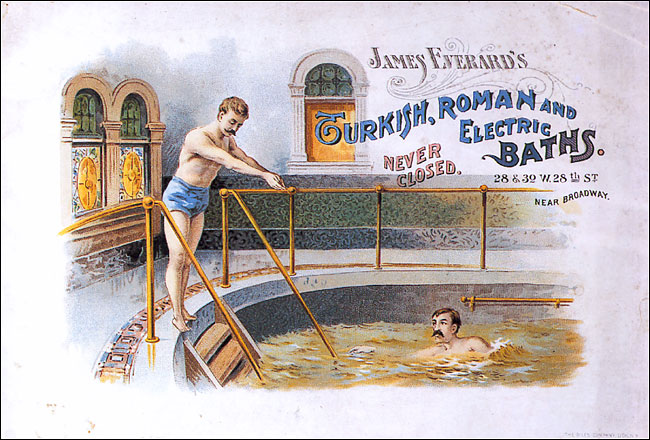Everard Baths, New York City: 1888 to 1985
Accessed from Wikipedia, Everard Baths, December 24, 2010.
UNDER CONSTRUCTION
The Everard Baths or Everard Spa Turkish Bathhouse was a gay bathhouse at 28 West 28th Street in New York City that operated from 1888 to 1985. The venue occupied an adaptively reused church building and was the site of a deadly fire.
 Cover of a brochure advertising the Everard Baths.
Cover of a brochure advertising the Everard Baths.
History: 1888
Everard Baths was a Turkish bath founded by financier James Everard in 1888 in a former church building, designed in a typical late-nineteenth-century Victorian architectural style, Romanesque Revival.
James Everard who operated the Everard brewery on 135th Street converted it to a bathhouse in 1888. Everard's bathhouse was intended for general health and fitness.[1]
1898, November 28
On November 28, 1898 a soldier was found dead in his room at the baths and gas was suspected.[2][3]
1919, January 5
On January 5, 1919 the New York Society for the Suppression of Vice encouraged a police raid in which the manager and nine customers were arrested for lewd behavior. It was raided again in 1920 with 15 arrests.[4]
1920s
By the 1920s, it was patronized largely by homosexuals and became the community's preeminent social venue from the 1930s onward.[5] It was patronized by gay men before the 1920s and by the 1930s had a reputation as "classiest, safest, and best known of the baths," eventually picking up the nickname, Everhard.[6]
The entrance was lit by two green lamps giving according to patrons the appearance of being a police precinct and giving rise to speculation that it was owned for a period by the Patrolmen's Benevolent Association of the City of New York (a claim that would be vehemently denied after patrons died in a 1979 fire).
1927
The actor Emlyn Williams described a visit in 1927:
- Up some stairs at a desk an ashen bored man in shirtsleeves produced a ledger crammed with illegible scrawls. I added mine, paid my dollar, was handed a key, towel and robe, hung the key on my wrist and mounted to a large floor as big as a warehouse and as high: intersecting rows of private rooms each windowless cell dark except from the glimmer from above through wire-netting shredded with dust and containing a narrow workhouse bed...[he later heard] a casual whisper, a sigh lighter than thistle-down, a smothered moan. Then appeasement: the snap of a lighter as two strangers sat back for a smoke and polite murmured small talk, such as they might exchange in a gym.[7]
Patrons
Among the documented patrons were Alfred Lunt, Lorenz Hart, Charles James, Gore Vidal and Nureyev.[8] Truman Capote and Ned Rorem wrote about their visits.[9]
1977, May 25
On May 25, 1977 nine patrons (ages 17 to 40) were killed in a fire: seven from smoke inhalation, one from respiratory burns, and one who had jumped from an upper floor. Contributing factors were the deteriorating conditions and the lack of sprinklers.[10]Firefighters said they were thwarted in rescue efforts by paneling covering the windows. Between 80 and 100 patrons left the building; the indefinite number was because the club did not have registration at the time. Most of the victims were identified by friends rather than family.[11] Accounts said costs were $5 for a locker or $7 for a cubicle ($6 and $9.25 on weekends).[12]
Despite the damage the baths would reopen.[13] However, it was closed in April 1986 by New York City mayor Ed Koch during the city’s campaign to close such venues during the AIDS epidemic.[10]
Popular culture
Michael Rumaker wrote a book A Day and a Night at the Baths devoted totally about the baths.[14]
The bath is also described in the book Dancer from the Dance by Andrew Holleran[15]
References
- ↑ J. Russiello, A Sympathetic Planning Hierarchy for Redundant Churches: A Comparison of Continued Use and Reuse in Denmark, England and the United States of America] (MSc Conservation of Historic Buildings, University of Bath, 2008), p. 383.
- ↑ Colter, Ephen Glenn. Policing public sex: queer politics and the future of AIDS activism. Dangerous Bedfellows, eds. Boston: South End Press, 1996. ISBN=9780896085497 | url=http://books.google.com/books?id=FqMoLytiNlUC}}
- ↑ "Ex-Soldier Killed by Gas". New York Times, November 29, 1898.
- ↑ Template:Citation
- ↑ Template:Harv
- ↑ Template:Harv
- ↑ Template:Citation
- ↑ Template:Citation
- ↑ Template:Citation
- ↑ 10.0 10.1 Scott Bronstein, “4 New York Bathhouses Still Operate Under City’s Program of Inspections,” New York Times (3 May 1987).
- ↑ 9 Killed in Bath Fire Identified by Friends - New York Times - May 27, 1977
- ↑ http://bitterqueen.typepad.com/history_of_gay_bars_in_ne/2007/12/the-everard-bat.html
- ↑ http://www.colors-of-leather.com/Lthr%20bars/Bars%202nd%20page/EFG/Everard%20Baths.htm
- ↑ A Day and a Night at the Baths by Michael Rumaker Grey Fox Press (1979) ISBN 0912516445
- ↑ Template:Citation
Internal links
External links
The Everard Baths is also extensively covered here: http://gaytubs.com/lengendary.htm <comments />